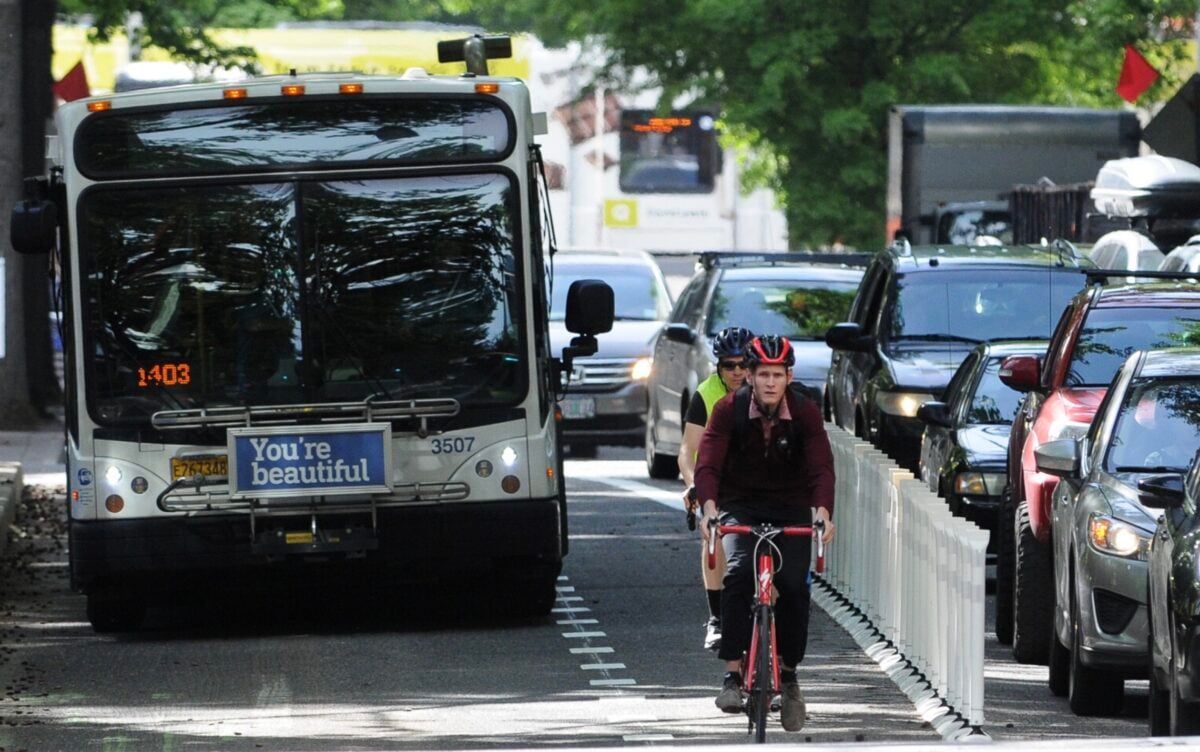
(Photo © J. Maus/BikePortland)
How safe is it for bicycle riders to share a “transit only” lane with bus and streetcar operators?
That’s a relevant question in Portland because the Rose Lane Project — a plan being considered by the City Council Thursday (2/13) — would see the implementation of just such an arrangement on local roads. And the answer is now a bit clearer thanks to new research from University of Pittsburgh, which found that bicycle users are safer in lanes they share with mass transit operators than those they share with car and truck drivers.
The new research, completed by a graduate student in civil engineering at Pitt, studied the safety performance of an existing shared bus-bike lane that runs through downtown Pittsburgh. Using video cameras stationed at four intersections over a four-day period, the study recorded interactions between bicycle and other vehicle users traveling in both the shared bus-bike lane and a contraflow general lane that riders share with drivers. Risky “conflict” behaviors, such as bike riders attempting to leapfrog or overtake buses, riders using the wrong lane, crossing through the opposite lane to reach the far sidewalk, or riding on the sidewalk, were recorded and tabulated as part of the research.
The report concluded that there is a clear safety advantage for bicycle users in the shared bus-bike lane as compared to general traffic lane. For the period of observation, the report found the conflicts between bikes and other vehicles in the shared bus-bike lane were were about half of those seen in the general lane. Per the data, 42.8% of general lane bicycle users observed had conflicts with car users while only 18.1% of bicycle users in shared bus-bike lane had conflicts with a bus operator.
“The results show that our hypothesis was corrected [sic] as cyclists traveling on the [shared bus-bike lane] will have a safer experience than cyclists traveling in the general traffic lane. Bikers in the [shared bus-bike lane], having to share the lane with only the buses, will have less conflicts to worry about,” concluded the author.
Advertisement
Part of the reduction in risk was due to the fact that there were fewer buses running in the shared bus-bike lane as compared to the general lane, resulting in less chance of conflicts. The report did note, however, that there were certain problems with having buses and bikes share a lane, such as bikes attempting to overtake or “leapfrog” buses (above) when the larger vehicles stopped to pick up passengers. Despite that issue, the author concluded that shared bus-bike lanes still came out on top in terms of reduced risks for bicycle riders.
How best to integrate bicycle and transit users in one lane will be a big discussion point in the Portland Bureau of Transportation’s (PBOT) Rose Lane Project, an initiative that envisions a variety of transit-priority treatments citywide. The project aims to improve transit service by giving buses and rail vehicles their own lane where they can’t stuck in traffic. PBOT staff will present its report and recommendations to the City Council for adoption in a hearing tomorrow. Bus-priority lanes have already been installed on SW Madison, NW Everett, and the Burnside Bridge and construction of 20 Phase 1 pilot projects will start this summer.
“While we do not believe that shared bus/bike lanes are a good design, we want to make it clear that people on bicycles should be allowed to ride in bus lanes, at least until protected bicycle lanes are provided on a corridor.”
— PBOT Bicycle Advisory Committee
As this plan has progressed, the issue of how Rose Lanes impact cycling facilities has simmered. The PBOT Bicycle Advisory Committee wrote a letter about the Rose Lane Project on January 23rd that said “world class bikeways” should be integrated into the designs. “While we do not believe that shared bus/bike lanes are a good design,” reads the letter, “we want to make it clear that people on bicycles should be allowed to ride in bus lanes, at least until protected bicycle lanes are provided on a corridor.”
“Impacts on bike facilities, such as changes to bike lane configuration,” is listed as a potential trade-off in the Rose Lane plan itself.
While PBOT includes shared bus-bike lanes as an option in their Enhanced Transit Corridors Toolbox, only one of the 29 publicly released Phase 1 projects, a short stretch of N. Whitaker Road in North Portland, proposes a shared bus-bike lane.
While publicly available information indicates that no other Phase 1 projects have shared bus-bike lanes, they could be integrated into Phase 2 projects that would be designed this year and constructed in 2021-2022.
Other planned treatments for Rose Lanes include transit-only lanes, road design modifications, signal improvements, and stop and station improvements, among others. Each pilot would be evaluated for performance in order to measure the benefits and trade-offs for the duration of the pilot. The Rose Lane Project is intended to advance PBOT’s transportation justice goals by reducing climate impacts and improving racial equity.
The Portland City Council will take up the issue this Thursday, February 13th at 2:00 p.m.
— Ian Edwards, ian@ianedws.com and @ianedws on Twitter
— Get our headlines delivered to your inbox.
— Support this independent community media outlet with a one-time contribution or monthly subscription.



